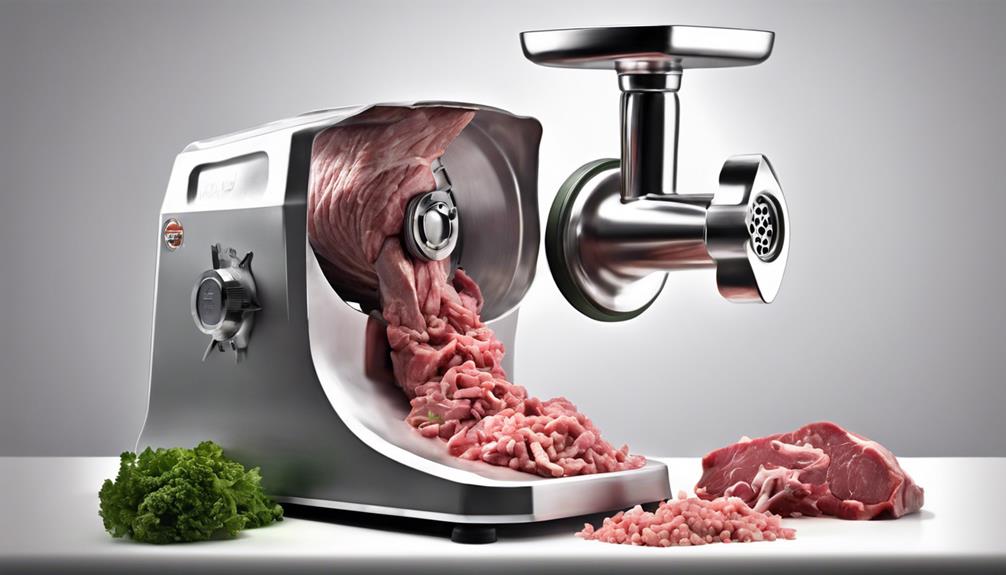I make high-quality dog food at home using organic, human-grade meats such as beef, chicken, turkey, and lamb. I also include fresh organs like liver, kidney, and heart to provide a well-balanced diet for my dog. I am knowledgeable about the nutritional requirements, ensuring 70% muscle meat, 10% raw edible bones, and 10% organs with essential amino acids and vitamins. By using a high-quality blender to mix and portion out meals based on my dog’s weight and daily caloric needs, I guarantee proper nutrition. Following clean food handling and safety practices is essential.
Safely storing the raw dog food ingredients and consulting with a vet or nutritionist for guidance on special dietary needs are also important in this process. These steps provide excellent nutrition personalized for my furry companion.
Key Takeaways
- Choose organic meats, organs, and bones for quality
- Understand dog's nutritional needs for a balanced diet
- Incorporate essential amino acids, vitamins, and minerals
- Prepare a mix of muscle meats and organ meats
- Use supplements like probiotics and calcium for health
Sourcing Quality Ingredients
When sourcing quality ingredients for homemade raw dog food, I always opt for organic, human-grade meats. These meats guarantee top safety and nutrition for my furry companion.
For my raw dog food recipes, I choose a variety of proteins such as beef, chicken, turkey, and lamb to provide balanced nutrition.
Including fresh organs like liver, kidney, and heart is essential as they offer essential nutrients that contribute to my dog's overall well-being.
Raw edible bones like chicken necks are also a staple in my recipes, providing calcium and promoting dental health.
Understanding Nutritional Requirements
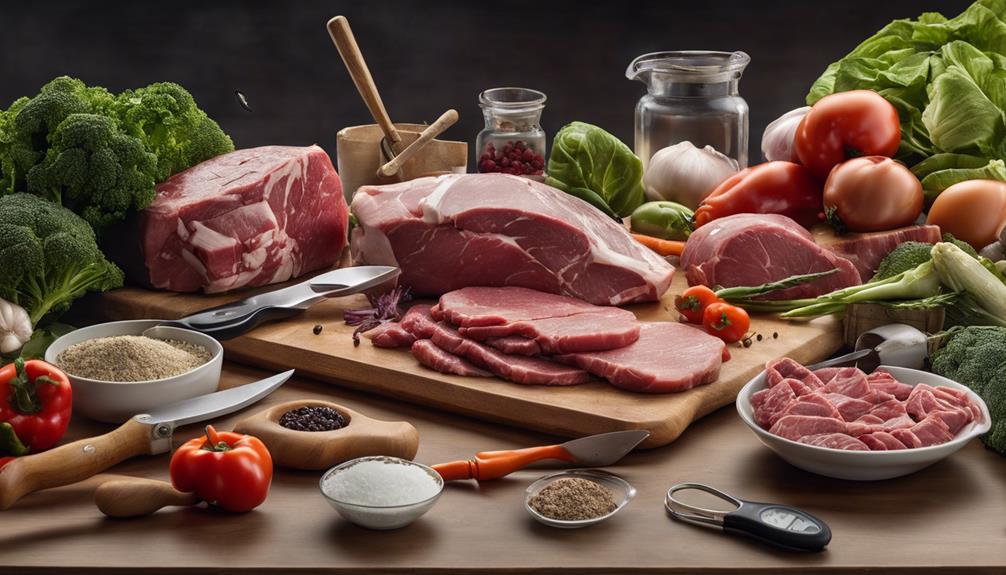
When preparing raw dog food at home, it's essential to grasp the nutritional requirements to guarantee a balanced diet for your furry companion.
Key components like muscle meat, raw edible bones, and organs play crucial roles in providing essential nutrients such as amino acids, calcium, and vitamins.
Including fresh vegetables, fruits, and other supplements in the right proportions further boosts the overall nutritional profile, supporting your dog's health and well-being.
Nutrient Needs
To guarantee excellent health for dogs, it's essential to provide a well-rounded diet that includes proteins, fats, carbohydrates, vitamins, and minerals. Here are three key points to keep in mind when meeting your dog's nutrient needs:
- Important Amino Acids: Make sure your homemade raw dog food recipes contain amino acids like taurine and arginine, essential for your dog's overall health and well-being.
- Calcium and Phosphorus Balance: Maintaining the correct equilibrium of calcium and phosphorus is crucial for bone health in dogs. Be mindful of these ratios in your recipes.
- Vitamin D: Adequate vitamin D is necessary for calcium absorption. Consider sunlight exposure or supplementation to meet this requirement in your dog's diet.
Balanced Diet
For understanding a dog's nutritional requirements, a balanced diet is essential to ensure peak health and well-being.
A balanced raw diet for dogs typically consists of:
- 70% muscle meat, providing essential amino acids and vitamins for overall health.
- 10% raw edible bones, offering important nutrients like calcium.
- 10% organs, which are nutrient-dense, with liver and kidneys providing essential vitamins such as vitamin A.
- 5% fresh vegetables/fruits, offering additional minerals and nutrients like apples, carrots, and sweet potatoes.
- The remaining 5% can be dairy/supplements/nuts/seeds, including whole eggs, plain yogurt, and beneficial supplements like flaxseed meal and fish oil, to enhance the overall nutritional value of the raw dog food recipe.
Preparing Meat and Organ Mix
When preparing the meat and organ mix for your raw dog food, it's essential to select a variety of muscle meats like chicken, beef, or turkey to form the base.
Incorporating organ meats such as liver, kidney, and heart adds essential nutrients like vitamins A and B to your dog's diet.
Achieving a balanced ratio of about 70% muscle meat to 10% organ meat guarantees your pet receives the necessary nutrition for best health.
Meat Selection
Selecting a variety of fresh, high-quality meats such as chicken, turkey, beef, lamb, or pork forms the foundation for preparing the raw dog food. When choosing meats for your raw dog food recipe, consider the following:
- Maintain a Balanced Ratio: Maintain a proper balance between muscle meat and organ meats in the mix to provide essential nutrients for your dog's health.
- Experiment with Different Combinations: Try out various meat combinations like ground beef, chicken necks, or lamb to find what suits your dog's taste and nutritional requirements best.
- Consider Grinding: Grinding the meats and organ meats together can aid in easier digestion and better absorption of nutrients by your furry companion.
Organ Proportion
In preparing the meat and organ mix for raw dog food, it is important to maintain a balanced proportion of organ meats to provide essential nutrients for your dog's health. Organ meats should make up about 10% of the raw dog food recipe to guarantee a balanced nutrient profile. Including liver, kidney, and heart in the mix offers a rich source of vitamins like A and B, minerals such as iron, and other critical nutrients necessary for your dog's well-being. By incorporating a variety of organ meats, you provide your canine companion with a diverse range of nutrients, mimicking a natural canine diet and supporting optimal health benefits. Here is a table outlining the importance of organ meats in a raw dog food recipe:
| Organ Meats | Nutrient Content | Benefits |
|---|---|---|
| Liver | Vitamin A, B vitamins | Essential for overall health |
| Kidney | Iron, other minerals | Supports vital bodily functions |
| Heart | Protein, Coenzyme Q10 | Promotes heart health |
Incorporating Essential Supplements
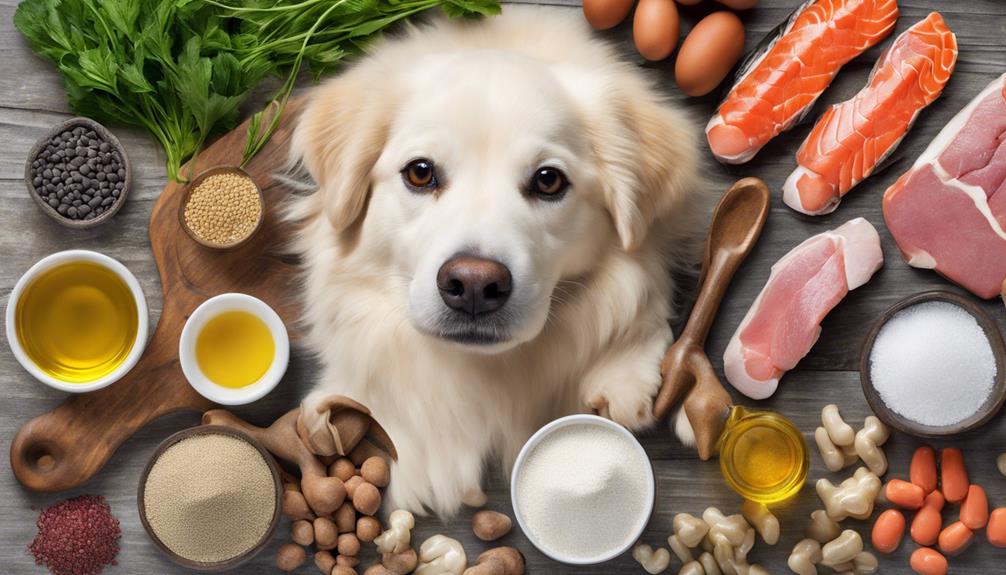
Including vital supplements in homemade raw dog food guarantees balanced nutrition for ideal canine health. When preparing raw dog food, it's crucial to make sure that your furry friend receives all the necessary nutrients.
Here are three key supplements to think about adding:
- Probiotics: These beneficial bacteria support your dog's digestive system and immune function, promoting overall well-being.
- Calcium Supplements: Ground eggshells or bone meal can help balance the phosphorus levels in raw dog food, vital for bone health and overall body function.
- Vitamin E Supplements: These can aid in preserving the freshness of the homemade raw dog food and contribute to your dog's overall health and vitality.
Utilizing a High-Quality Blender
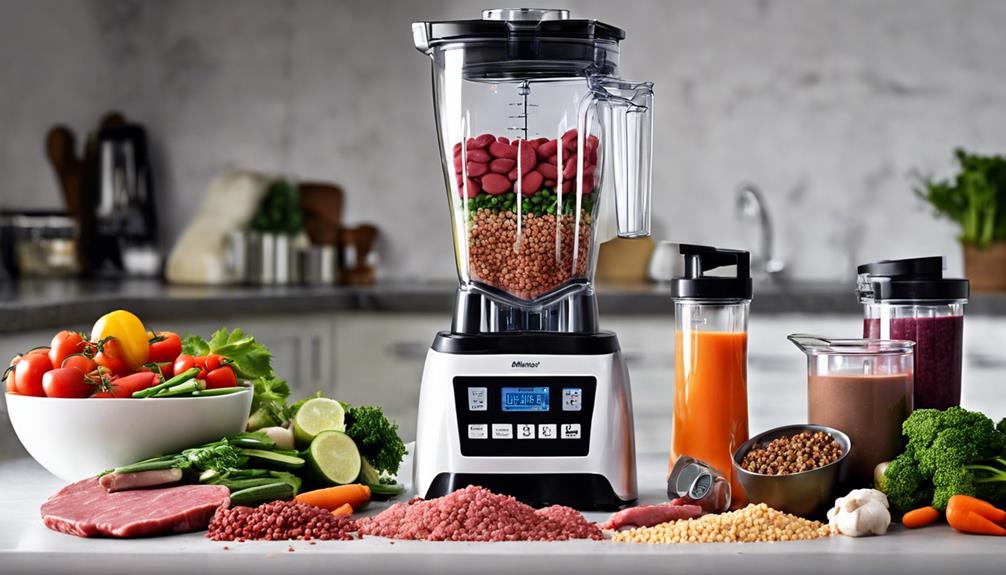
When moving from ensuring proper supplementation in homemade raw dog food to optimizing the food preparation process, a high-quality blender becomes a critical tool for seamlessly processing all essential ingredients.
A powerful blender is essential for efficiently grinding raw dog food ingredients such as meat, bones, and vegetables, ensuring a well-balanced meal for your furry friend. The sharp blades of a quality blender can effectively grind bones to a safe consistency for consumption, releasing essential nutrients for your pet's nutrition.
Using a blender guarantees a homogeneous mixture of all ingredients, promoting balanced nutrition in each serving. By thoroughly blending all components into a smooth consistency, the risk of choking hazards is significantly reduced.
Properly blended raw dog food ingredients not only enhance the taste but also aid in digestion, making it easier for your pet to absorb the necessary nutrients. Invest in a high-quality blender to streamline the processing of raw dog food ingredients and ensure your pet receives the best nutrition with every meal.
Portioning Out Meals
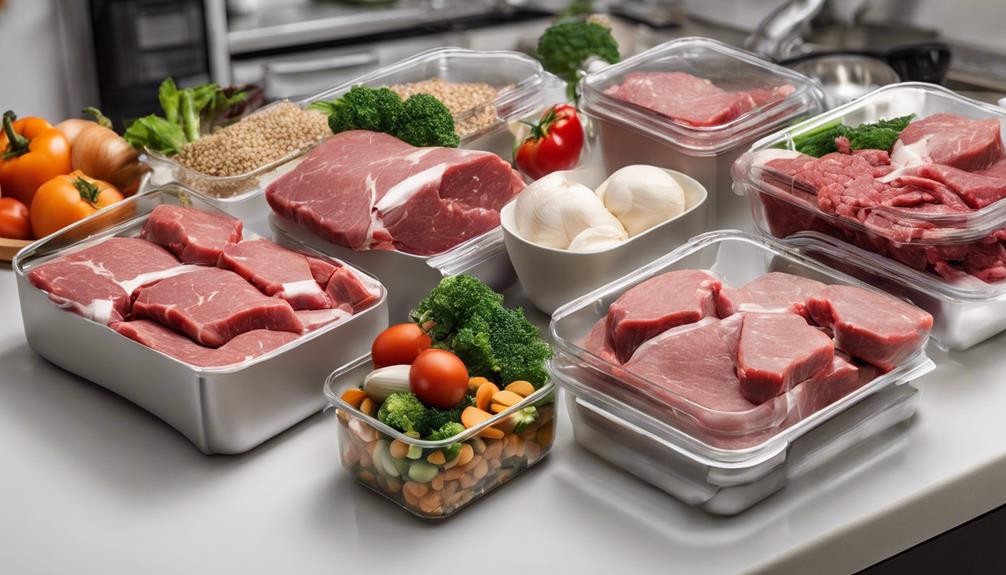
To guarantee top nutrition and digestion for your dog, precisely portion out raw dog food meals based on their weight and daily caloric requirements.
- Consider Body Weight: Tailor portion sizes to your dog's weight, ensuring they receive the right amount of nutrients.
- Assess Daily Caloric Needs: Calculate the daily caloric needs of your dog based on factors like age, breed, and activity level to determine the appropriate portion sizes.
- Adjust for Activity Level: Dogs with higher activity levels may require more food, so adjust portion sizes accordingly to meet their energy demands.
Ensuring Proper Food Handling
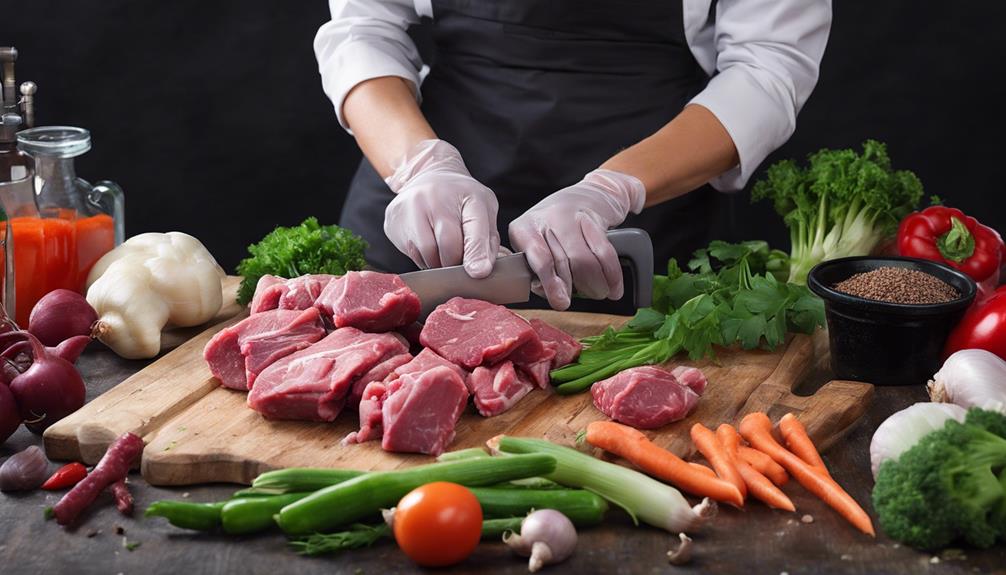
When handling raw dog food, it's vital to maintain a clean food prep area, store ingredients properly, and use separate utensils to prevent the spread of bacteria.
Washing hands thoroughly before and after handling raw dog food is essential to avoid cross-contamination.
Thawing frozen raw dog food in the refrigerator or microwave, rather than on the counter, helps maintain food safety.
Clean Food Prep Area
Using stainless steel bowls and utensils is essential for preventing contamination and ensuring easy cleanup when preparing raw dog food at home. Here are three key steps to maintain a clean food prep area:
- Wash all surfaces, utensils, and hands with hot, soapy water before and after handling raw dog food ingredients.
- Store raw dog food ingredients separately from human food to avoid cross-contamination.
- Use cutting boards designated for raw dog food preparation to prevent the spread of bacteria.
Store Ingredients Properly
After guaranteeing a clean food prep area, the next step is properly storing raw dog food ingredients to maintain freshness and prevent contamination.
Store raw meat in the coldest part of the refrigerator, below 40°F, to prevent bacterial growth. It's crucial to use a separate cutting board for raw meat and vegetables to avoid cross-contamination.
Keep raw dog food ingredients tightly sealed in airtight containers to maintain freshness and prevent odors. Remember to label and date all homemade raw dog food ingredients to track freshness and ensure timely use.
When thawing frozen ingredients, do so in the refrigerator or under cold water to prevent bacterial growth during the thawing process. By following these storage practices, you can guarantee the safety and quality of your raw dog food.
Use Separate Utensils
To ensure proper food handling when preparing raw dog food at home, reserve stainless steel bowls, knives, and cutting boards exclusively for this purpose to avoid cross-contamination.
Wash and sanitize utensils and surfaces thoroughly after each use to eliminate any harmful bacteria that may be present.
Store raw dog food ingredients separately from human food to prevent any accidental mixing or contamination.
Use gloves when handling raw meat to protect yourself from potential pathogens and maintain hygiene standards.
Ensuring that you have separate utensils for preparing raw dog food is essential in preventing the spread of harmful bacteria and keeping your pet safe and healthy. By following these steps, you can maintain a clean and safe food preparation environment for your furry friend.
Storing Raw Dog Food Safely
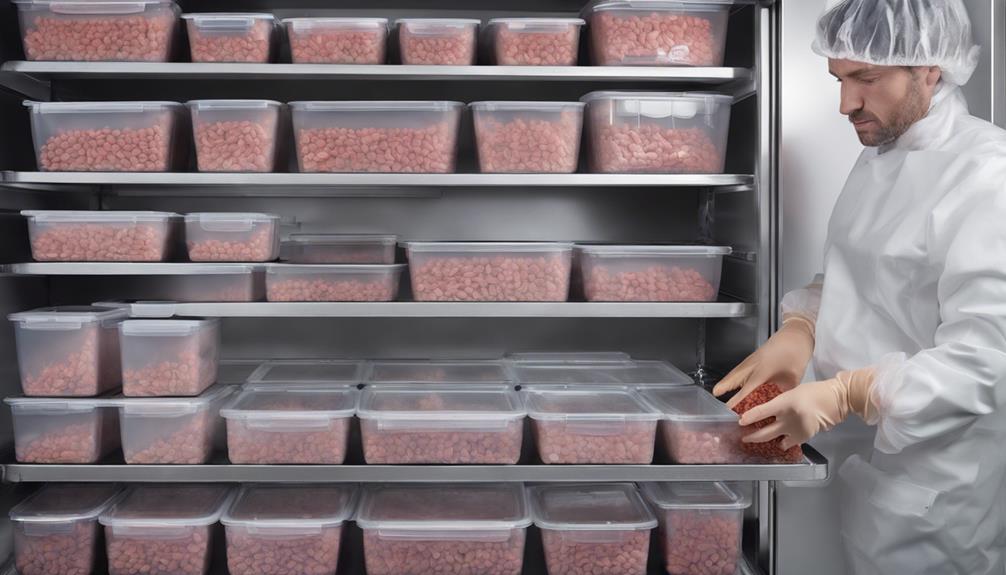
When storing raw dog food safely, it's crucial to use airtight containers in the refrigerator for short-term storage. Raw dog food can be kept in these containers for up to 3-4 days to maintain its freshness and prevent contamination.
For longer storage, freezing raw dog food in portioned containers is recommended, extending its shelf life to several months. Remember to label the containers with the date of preparation to track freshness and guarantee proper rotation.
When ready to serve frozen raw dog food, thaw it in the refrigerator overnight to preserve its quality. It's important to avoid refreezing thawed raw dog food to prevent potential bacterial growth and maintain its nutritional value.
Consulting With a Vet or Nutritionist
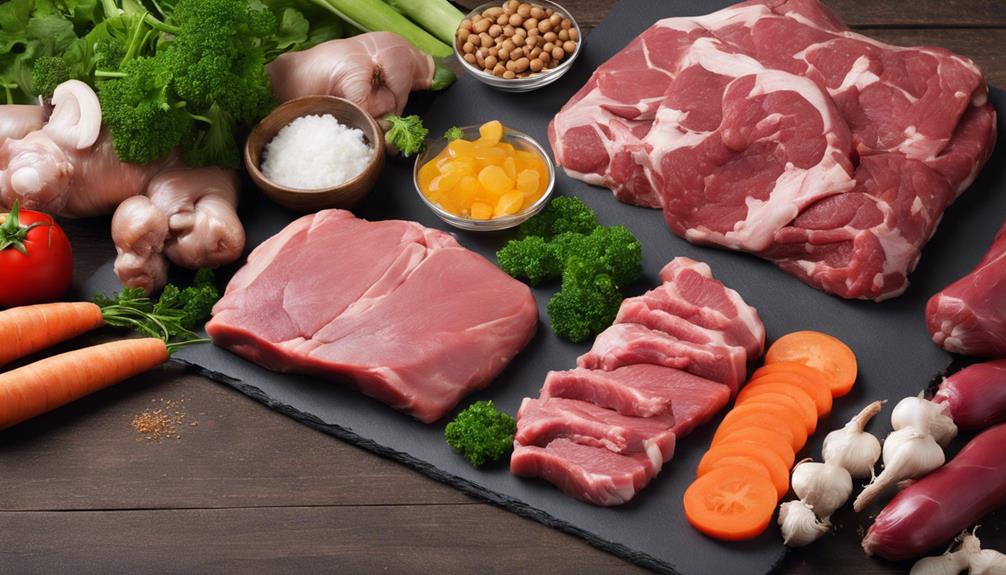
Seeking advice from a veterinarian or nutritionist is essential to guarantee that your raw dog food recipe meets your dog's specific nutritional needs.
Here are three vital points to keep in mind when consulting with a professional:
- Guidance on Nutritional Requirements: Vets can provide valuable insights into selecting the right ingredients, determining portion sizes, and making necessary dietary adjustments to make sure your dog's health is at its best.
- Balancing Essential Nutrients: Nutritionists offer expertise in balancing crucial nutrients like proteins, fats, and vitamins in your homemade raw dog food, helping to create a well-rounded diet for your furry friend.
- Addressing Special Needs: Professional advice can help address concerns such as allergies, sensitivities, or any special dietary requirements your dog may have, ensuring that the homemade raw dog food is tailored to your pet's unique needs.
Consulting with a vet or nutritionist regularly can also aid in monitoring your dog's health and making any essential dietary changes over time.
Experimenting With Different Recipes
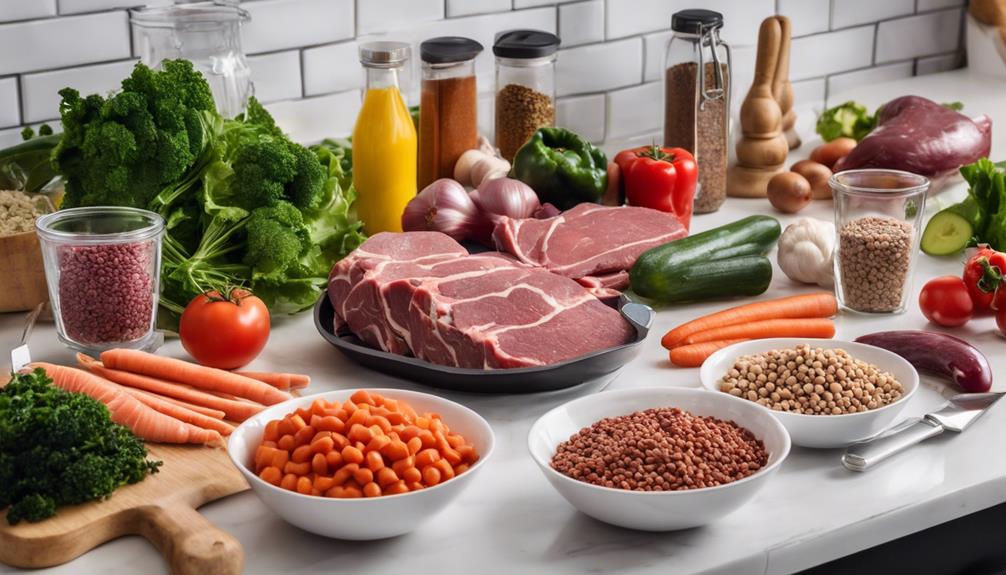
After consulting with a vet or nutritionist to make certain your raw dog food recipe meets your dog's specific nutritional needs, it's time to start experimenting with different recipes to provide a well-rounded diet for your furry friend.
When creating homemade dog food recipes, it's imperative to experiment with different protein sources such as chicken, beef, turkey, and lamb. These proteins offer a variety of nutrients important for your dog's health. Additionally, incorporating organ meats like liver, kidney, and heart can guarantee a balanced diet rich in essential vitamins and minerals.
Don't forget to add fresh vegetables like spinach, kale, and broccoli to provide fiber, antioxidants, and additional vitamins to your dog's raw food. Adjusting recipes based on your dog's dietary needs and preferences is crucial. Consider including nutritional boosters or supplements like Canident to enhance the overall nutritional value of the homemade raw dog food and tailor it to your dog's individual requirements.
Experimenting with different recipes allows you to find the perfect balance for your furry companion's health and happiness.
Frequently Asked Questions
How to Make Your Own Raw Dog Food?
I create my own raw dog food by choosing top-notch meats, raw consumable bones, organ meats, and fresh vegetables. I guarantee a balanced meal by incorporating Canident or other nutritional boosters. It's crucial for my furry friend's health and well-being.
How to Make 80 10 10 Raw Dog Food?
Crafting 80 10 10 raw dog food involves harmonizing muscle meat, raw edible bones, and organs to meet a dog's nutritional needs. This ratio guarantees vital nutrients like protein, calcium, and vitamins are supplied, promoting overall health.
What Is the Best Mix for Raw Dog Food?
I've found the best mix for raw dog food includes 70% muscle meat for essential amino acids, 10% raw edible bones for calcium, 10% organs like liver for key nutrients, 5% fresh veggies/fruits for minerals, and 5% dairy/supplements/nuts/seeds for added benefits.
What Is the Formula for Raw Food for Dogs?
The formula for raw dog food includes a balance of muscle meat, raw edible bones, organs, fresh vegetables/fruits, and dairy/supplements/nuts/seeds. This mix provides essential nutrients like calcium, vitamins, and minerals important for a dog's health and well-being.
What Are the Best Methods for Selling Homemade Raw Dog Food?
When it comes to the ultimate raw dog food sales, utilizing online platforms such as social media and e-commerce websites can be highly effective. Additionally, partnering with local pet stores or participating in pet expos and events can help reach a wider audience and boost sales for homemade raw dog food.
Conclusion
To sum up, preparing homemade raw dog food is a gratifying and advantageous method to guarantee your four-legged companion gets a nutritious diet. By adhering to these 10 easy steps, you can supply your dog with a wholesome and well-rounded meal customized to their specific requirements.
So why not give it a try and witness the impact it can have on your pet's well-being and joy? Your dog will express their gratitude with wagging tails and affectionate kisses!
